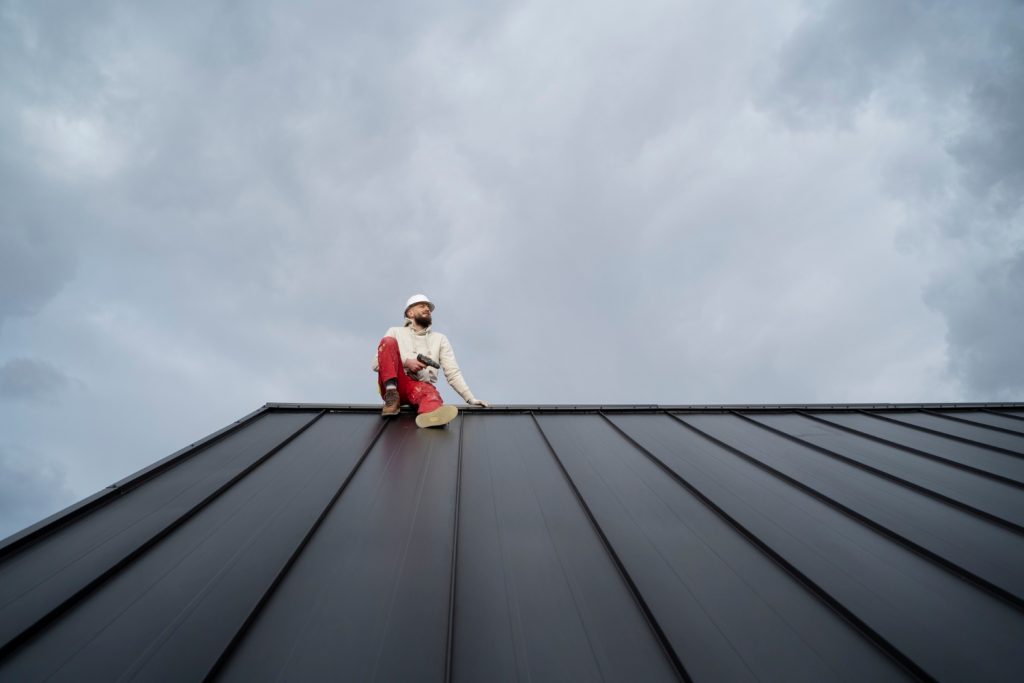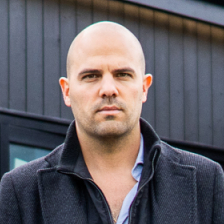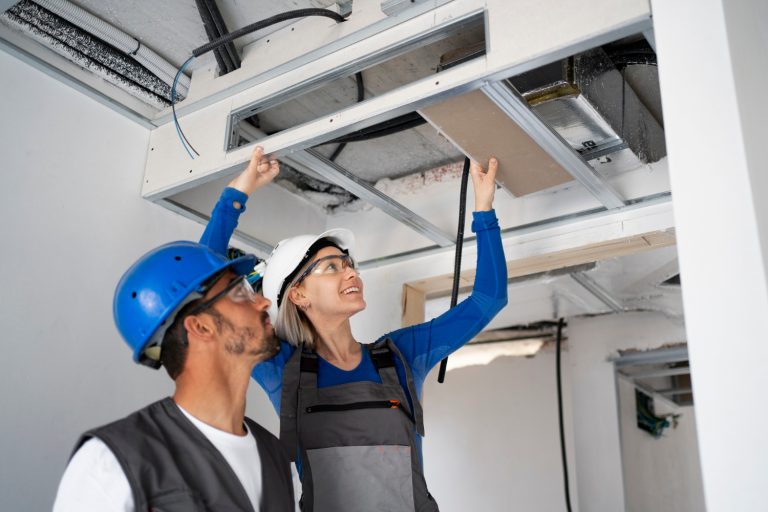Why Roof Replacement Planning Matters
Commercial roofs represent 15-25 percent of a building’s total replacement value. In the Bay Area, where property values run high and weather patterns create unique challenges, roof replacement ranks among the most significant capital expenditures property managers face.
Most commercial roofs last 15-30 years depending on type, installation quality, and maintenance. Planning ahead prevents emergency replacements that cost 30-50 percent more than scheduled projects.
At GC44, we work with property managers and building owners throughout the roof replacement process. This guide provides comprehensive Bay Area pricing, system comparisons, and strategies to maximize ROI on this substantial investment.
Average Commercial Roof Replacement Costs
Bay Area commercial roof replacement cost varies significantly based on system type, building characteristics, and project complexity.
2025 Bay Area Pricing by System
Built-Up Roofing (BUR)
- Cost: 7−7−12 per square foot installed
- Best for: Traditional flat roofs, heavy traffic areas
- Lifespan: 15-20 years
Modified Bitumen
- Cost: 8−8−14 per square foot installed
- Best for: Low-slope roofs, moderate climate
- Lifespan: 15-25 years
EPDM (Rubber Roofing)
- Cost: 9−9−15 per square foot installed
- Best for: Flat or low-slope commercial buildings
- Lifespan: 20-30 years
TPO (Thermoplastic Polyolefin)
- Cost: 10−10−17 per square foot installed
- Best for: Energy efficiency, reflective roofing
- Lifespan: 20-30 years
PVC (Polyvinyl Chloride)
- Cost: 12−12−20 per square foot installed
- Best for: Restaurants, chemical exposure areas
- Lifespan: 20-35 years
Metal Roofing
- Cost: 15−15−25 per square foot installed
- Best for: Longevity, sustainability
- Lifespan: 30-50 years
Green Roofs
- Cost: 25−25−40 per square foot installed
- Best for: Sustainability goals, urban environments
- Lifespan: 30-50 years
These prices include materials, labor, permits, and basic tear-off. Complex projects with structural repairs or extensive penetrations add 20-40 percent to base costs.
Cost Factors That Impact Pricing
Building Size
Larger roofs benefit from economies of scale:
- Under 5,000 sf: Premium pricing per sf
- 5,000-15,000 sf: Standard pricing
- 15,000-50,000 sf: 10-15 percent discount
- Over 50,000 sf: 15-25 percent discount
Roof Accessibility
- Ground-level access: Standard pricing
- Crane required: Add 5,000−5,000−15,000
- Restricted access (downtown): Add 15-25 percent
- Occupied building constraints: Add 10-20 percent
Existing Roof Condition
- Clean tear-off: Standard pricing
- Wet insulation: Add 2−2−4 per sf
- Structural repairs needed: Add 5−5−15 per sf
- Decking replacement: Add 8−8−12 per sf
Penetrations and Details
- HVAC units: 500−500−1,500 per unit for flashing
- Skylights: 300−300−800 each
- Drains and scuppers: 200−200−500 each
- Parapets and walls: 15−15−30 per linear foot
Permits and Code Compliance
- Standard permit: 1,500−1,500−4,000
- Seismic upgrades required: Add 3−3−8 per sf
- Title 24 cool roof requirements: May dictate system choice
- Fire rating upgrades: Add 2−2−5 per sf
Roof System Comparison
TPO vs. EPDM: The Most Common Choice
Bay Area property owners most frequently choose between TPO and EPDM for commercial flat roofs.
TPO Advantages
- Energy-efficient white surface reduces cooling costs
- Heat-welded seams stronger than adhesive
- Better puncture resistance
- Meets California Title 24 cool roof requirements
- Lower long-term maintenance
EPDM Advantages
- Lower initial cost (1−1−2 per sf less)
- Proven 50+ year track record
- Easier installation in cold weather
- Flexible in freeze-thaw cycles
- Repairable with simple tools
Recommendation
TPO delivers better value for Bay Area properties despite 10-15 percent higher initial costs. Energy savings of 0.10−0.10−0.25 per sf annually provide payback in 5-8 years. EPDM remains viable for budget-constrained projects or buildings with minimal cooling loads.
PVC: Premium Performance
PVC costs 20-40 percent more than TPO but offers advantages for specific applications:
- Superior chemical resistance (restaurants with grease)
- Longest lifespan of single-ply membranes
- Best fire resistance ratings
- Strongest welded seams
- Widest color options
For buildings requiring maximum longevity or facing chemical exposure, PVC justifies premium pricing.
Metal Roofing: Long-Term Investment
Metal roofing costs double TPO initially but lasts twice as long. Consider metal when:
- Building ownership exceeds 20 years
- Sustainability certifications pursued
- Sloped roof applications
- Architectural aesthetics matter
Lifecycle costs favor metal for long-term holds despite higher upfront investment.
Bay Area Specific Considerations
Seismic Requirements
California seismic codes require roof systems to resist lateral forces. Compliance adds costs:
- Parapet bracing: 20−20−40 per linear foot
- HVAC seismic restraints: 1,000−1,000−3,000 per unit
- Skylight upgrades: 500−500−1,500 each
Title 24 Cool Roof Mandates
California energy codes require roofs to meet minimum solar reflectance and thermal emittance values. This affects material selection:
- TPO: Typically compliant
- PVC: Typically compliant
- EPDM: Requires white coating (add 1−1−2 per sf)
- Modified bitumen: Requires reflective cap sheet
- Metal: Light colors required
Fog and Moisture
Coastal Bay Area buildings face persistent moisture. Address with:
- Enhanced insulation to prevent condensation
- Vapor barriers below insulation
- Increased drainage capacity
- Faster-drying insulation materials
Fire Ratings
Urban Bay Area properties often require Class A fire ratings. Verify system compliance before selection. Upgrades for better fire ratings add 2−2−5 per sf.
Total Project Cost Breakdown
Understanding complete replacement costs prevents budget surprises.
Example: 20,000 SF Office Building TPO Roof Replacement
Material and Installation
- TPO membrane system: 13persfx20,000sf=13persfx20,000sf=260,000
Tear-Off and Disposal
- Existing roof removal: 2persfx20,000sf=2persfx20,000sf=40,000
Insulation
- R-30 polyiso insulation: 3persfx20,000sf=3persfx20,000sf=60,000
Detail Work
- HVAC units (8): 1,000each=1,000each=8,000
- Parapets: 400 linear ft x 25=25=10,000
- Drains and penetrations: $8,000
Permits and Engineering
- Building permits and inspections = $3,500
- Structural engineer (if needed) = $4,000
Contingency
- 10 percent for unknowns = $39,350
Total Project Cost: 432,850∗∗∗∗CostPerSquareFoot:432,850∗∗∗∗CostPerSquareFoot:21.64
This comprehensive figure reflects typical Bay Area commercial roof replacement for standard conditions.
ROI and Payback Analysis
Energy Savings
Cool roof systems reduce cooling costs:
- Bay Area office building: 0.15−0.15−0.30 per sf annual savings
- Retail with high cooling loads: 0.25−0.25−0.50 per sf annual savings
- Warehouse with limited HVAC: 0.05−0.05−0.15 per sf annual savings
20,000 sf office example:
- TPO cool roof premium over EPDM: $20,000
- Annual cooling savings: $4,000
- Simple payback: 5 years
Property Value Impact
New roofs increase property value and marketability:
- Immediate value increase: 50-70 percent of replacement cost
- Improved cap rates for investment properties
- Enhanced tenant appeal
- Reduced insurance premiums (5-10 percent typical)
Avoided Emergency Costs
Planned replacements cost 30-50 percent less than emergency repairs:
- No interior damage from leaks
- No business interruption
- Lower contractor pricing for scheduled work
- Better material choices with planning time
Maintenance and Lifecycle Extension
Preventive Maintenance Programs
Proper maintenance extends roof life 5-10 years:
- Bi-annual inspections: 500−500−1,000 per visit
- Minor repairs: 2,000−2,000−5,000 annually
- Drain cleaning: 300−300−800 semi-annually
- Re-coating (years 12-15): 3−3−6 per sf
Annual Maintenance Budget
Plan 0.10−0.10−0.25 per sf annually for maintenance. For 20,000 sf building: 2,000−2,000−5,000 per year prevents major issues.
Restoration vs. Replacement
Some roofs qualify for restoration rather than full replacement:
- Silicone roof coatings: 4−4−7 per sf
- Extends life 10-15 years
- Improves energy efficiency
- Qualifies when membrane remains sound
Restoration costs 30-40 percent of replacement while adding significant life.
Financing Options
Capital Expenditure Planning
Most property owners budget replacements through:
- Reserve funds (HOAs, REITs)
- Planned capital improvement schedules
- Depreciation and cash flow
Commercial Loans
Banks offer equipment financing for roofing:
- Terms: 5-10 years typical
- Rates: Prime + 2-4 points (8-10 percent in 2025)
- Down payment: 10-20 percent
- Fast approval for established businesses
PACE Financing
Property Assessed Clean Energy loans fund energy-efficient upgrades:
- Repaid through property tax assessments
- Terms: Up to 20 years
- Rates: 6-8 percent typical
- Transferable to new owners
Utility Rebates
Bay Area utilities offer cool roof rebates:
- PG&E: Up to $0.20 per sf for cool roofs
- Silicon Valley Clean Energy: 0.15−0.15−0.30 per sf
- Peninsula Clean Energy: 0.10−0.10−0.25 per sf
20,000 sf building example: 3,000−3,000−6,000 in rebates
Contractor Selection
Essential Qualifications
- California C-39 roofing license
- Minimum $2 million general liability insurance
- Workers compensation coverage
- Local references from similar projects
- Manufacturer certifications for specified systems
Red Flags
- Unusually low bids (30+ percent below others)
- Pressure for immediate decisions
- No physical business address
- Requests for full payment upfront
- No written warranties
Warranty Considerations
- Manufacturer material warranty: 15-30 years typical
- Contractor workmanship warranty: Minimum 5 years
- Extended warranties: Available for premium pricing
- Transferability: Important for investment properties
Project Timeline
Planning Phase: 2-4 Months
- Engineering and design
- Bid process and contractor selection
- Permit applications
- Tenant notifications
Permitting: 3-8 Weeks
- Plan review
- Structural review if needed
- Permit issuance
Construction: Variable by Size
- 5,000 sf building: 3-5 days
- 15,000 sf building: 1-2 weeks
- 50,000 sf building: 3-6 weeks
- Weather delays add time
Total Project Duration: 4-7 Months from decision to completion
Case Example: Palo Alto Office Building
GC44 recently completed a roof replacement for a 35,000 sf Class B office building in Palo Alto.
Existing Conditions
- 22-year-old built-up roof
- Multiple leak areas
- Inadequate drainage
- Below-code insulation
Solution
- TPO fully-adhered system
- Upgraded to R-30 insulation
- Improved drainage layout
- Seismic parapet upgrades
Project Details
- Duration: 3 weeks
- Cost: 680,000(680,000(19.43 per sf)
- Utility rebates: $7,000
- Net cost: $673,000
Results
- 30-year manufacturer warranty
- Zero leaks in first year
- 22 percent reduction in cooling costs
- Improved tenant satisfaction
- Property value increase: $400,000+
Common Mistakes to Avoid
Delaying Too Long
Waiting until failure forces emergency replacement at premium pricing. Plan when roof reaches 75 percent of expected life.
Selecting Lowest Bid
Cheapest contractors cut corners. Focus on value: quality materials, proper installation, solid warranties.
Ignoring Insulation
Replacing membrane without upgrading insulation wastes opportunity. Improved insulation provides ongoing energy savings.
Overlooking Drainage
Poor drainage causes premature failure. Evaluate and improve drainage during replacement.
Skipping Engineering
For buildings over 20,000 sf or with existing issues, structural engineering prevents future problems.
Final Thoughts
Commercial roof replacement represents a significant investment, but proper planning and execution deliver decades of reliable protection and energy savings. Bay Area property owners benefit from understanding system options, realistic costs, and strategies to maximize value.
Success requires selecting appropriate systems for climate and use, working with qualified contractors, addressing underlying issues during replacement, and maintaining roofs proactively after installation.
At GC44, we provide complete roof replacement services for commercial properties throughout the Bay Area. Our experience with local codes, system selection, and construction management ensures projects deliver on time, on budget, and with quality that lasts.
Contact GC44 to discuss your commercial roof replacement needs. We provide assessments, budget planning, and turnkey construction services for property managers and building owners throughout Silicon Valley and the Peninsula.





